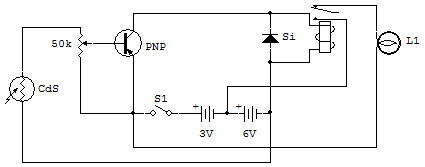
Night Light

One very practical use for the CdS Cell is to turn lights ON or OFF at sunrise or sunset. This circuit will automatically turn ON the Lamp at night.
Try studying the Schematic before you look at the explanation below, and see if you can figure out what's going on in this circuit. Then see if your notes match our's. If they do ... GREAT! If they don't, at least you'll be sure to remember it next time.
Circuit operation is as follows:
1. Adjust the Control until you reach the point where the light comes ON.
2. Reduce the Control setting just enough to turn the light OFF, again.
Once the project is set, it will light the Lamp whenever the level of light around the CdS dims. As you probably guessed, the CdS in this circuit controls the base current to the 2SA(1) Transistor. When the light on the CdS is relatively high, the resistance through the CdS is low, and enough base current flows to turn ON the 2SA(1).
When the 2SA(1) is ON, its C-E circuit conducts and short circuits the current past the base of the 2SA(2). Transistor (the 2SA(2) is therefore OFF). With the 2SA(2) OFF, no current flows through its C-E junction and the Relay coil is de-energized.
The Relay is in the normally open position, so the Lamp is OFF. When the light around the CdS dims, the resistance increases and turns OFF the 2SA(1). Now the current can flow to the base of the 2SA(2) which turns it ON and energizes the Relay coil. This pulls the contact points of the Relay to the closed position and turns on the Lamp.
The Control in this circuit allows you to set the Lamp to come ON with different amount of light (or should we say darkness).
CAUTION: To avoid damage to the Transistor, be sure to set the Control to 0 before wiring this circuit.
